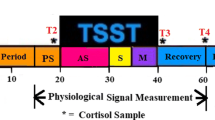Abstract
In the present time, stress is one of the major problems in human life. Person from every age group is facing stress and have increased major diseases such as distressing, heart diseases, and others. As we know “Prevention is better than cure” so, early recognition of mental stress can avoid many stress-related problems both physically and mentally including heart stroke and depression. When a person is stressed, many biological signals such as heat, electricity, impedance, acoustics, and optics change take place in their body and these biological signals can be used to evaluate stress levels. In this study, WESAD (Wearable Stress and Affect Detection) dataset is used, which is collected using wearable sensing devices such as wrist-worn. Further, multiple machine and deep learning models including support vector machine (SVM), Decision Tree (DT), k-nearest neighbors (k-NN), and long short-term memory (LSTM) are used for detecting human stress. The result shows that the LSTM achieved high model accuracy in comparison with other models in terms of precision (97.01%), recall (97.00%), F1-score (97.03%), and accuracy (98.00%). So, from the result, it is confirmed that LSTM modal may be used as stress prediction model.
Access this chapter
Tax calculation will be finalised at checkout
Purchases are for personal use only
Similar content being viewed by others
References
Selye H (1965) The stress syndrome. Am J Nurs 97–99
Giannakakis G, Grigoriadis D, Giannakaki K, Simantiraki O, Roniotis A, Tsiknakis M (2019) Review on psychological stress detection using biosignals. IEEE Trans Affect Comput
Lazarus J (2000) Stress relief & relaxation techniques, McGraw Hill Professional
Bakker J, Pechenizkiy M, Sidorova N (2011) What's your current stress level? Detection of stress patterns from GSR sensor data. In: 2011 IEEE 11th international conference on data mining workshops. IEEE, pp 573–580
Malviya L, Mal S, Lalwani P (2021) EEG data analysis for stress detection. In: 2021 10th IEEE international conference on communication systems and network technologies (CSNT). IEEE, pp 148–152
Gedam S, Paul S (2021) A review on mental stress detection using wearable sensors and machine learning techniques. IEEE Access
Al-Saggaf UM, Naqvi SF, Moinuddin M, Alfakeh SA, Azhar Ali SS (2022) Performance evaluation of EEG based mental stress assessment approaches for wearable devices. Front Neurorobotics 15:819448
Gedam S, Paul S (2020) Automatic stress detection using wearable sensors and machine learning: a review. In: 2020 11th international conference on computing, communication and networking technologies (ICCCNT). IEEE, pp 1–7
Colligan TW, Higgins EM (2006) Workplace stress: etiology and consequences. J Workplace Behav Health 21(2):89–97
O'Connor DB, Thayer JF, Vedhara K (2021) Stress and health: a review of psychobiological processes. Annu Rev Psychol 72:663–688
Thoits PA (2010) Stress and health: major findings and policy implications. J Health Soc Behav 51(1):S41–S53
Garg A, Chren M-M, Sands LP, Matsui MS, Marenus KD, Feingold KR, Elias PM (2001) Psychological stress perturbs epidermal permeability barrier homeostasis: implications for the pathogenesis of stress-associated skin disorders. Arch Dermatol 137(1):53–59
Adam TC, Epel ES (2007) Stress, eating and the reward system. Physiol Behav 91(4):449–458
Hou X, Liu Y, Sourina O, Tan YR, Wang L, Mueller-Wittig W (2015) EEG based stress monitoring. In: 2015 IEEE international conference on systems, man, and cybernetics. IEEE, pp 3110–3115
Holmes TH, Rahe RH (1967) The social readjustment rating scale. J Psychosom Res
Monroe SM (2008) Modern approaches to conceptualizing and measuring human life stress. Annu Rev Clin Psychol 4:33–52
Weiner IB, Edward Craighead W (eds) (2010) The Corsini encyclopedia of psychology, vol 4. Wiley
Ciabattoni L, Ferracuti F, Longhi S, Pepa L, Romeo L, Verdini F (2017) Real-time mental stress detection based on smartwatch. In: 2017 IEEE international conference on consumer electronics (ICCE). IEEE, pp 110–111
Can YS, Arnrich B, Ersoy C (2019) Stress detection in daily life scenarios using smart phones and wearable sensors: a survey. J Biomed Inform 92:103139
Anderson A, Hsiao T, Metsis V (2017) Classification of emotional arousal during multimedia exposure. In: Proceedings of the 10th international conference on pervasive technologies related to assistive environments, pp 181–184
Sun F-T, Kuo C, Cheng H-T, Buthpitiya S, Collins P, Griss M (2010) Activity-aware mental stress detection using physiological sensors. In: International conference on mobile computing, applications, and services. Springer, Berlin, Heidelberg, pp 282–301
Castaldo R, Melillo P, Bracale U, Caserta M, Triassi M, Pecchia L (2015) Acute mental stress assessment via short term HRV analysis in healthy adults: a systematic review with meta-analysis. Biomed Signal Process Control 18:370–377
Bajpai D, He L (2020) Evaluating KNN performance on WESAD dataset: In: 2020 12th international conference on computational intelligence and communication networks (CICN). IEEE, pp 60–62
Author information
Authors and Affiliations
Corresponding author
Editor information
Editors and Affiliations
Rights and permissions
Copyright information
© 2023 The Author(s), under exclusive license to Springer Nature Singapore Pte Ltd.
About this paper
Cite this paper
Malviya, L. et al. (2023). Mental Stress Level Detection Using LSTM for WESAD Dataset. In: Khanna, A., Polkowski, Z., Castillo, O. (eds) Proceedings of Data Analytics and Management . Lecture Notes in Networks and Systems, vol 572. Springer, Singapore. https://doi.org/10.1007/978-981-19-7615-5_22
Download citation
DOI: https://doi.org/10.1007/978-981-19-7615-5_22
Published:
Publisher Name: Springer, Singapore
Print ISBN: 978-981-19-7614-8
Online ISBN: 978-981-19-7615-5
eBook Packages: Intelligent Technologies and RoboticsIntelligent Technologies and Robotics (R0)




